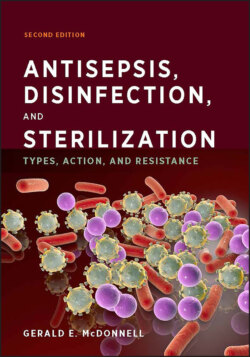Читать книгу Antisepsis, Disinfection, and Sterilization - Gerald E. McDonnell - Страница 10
Оглавление
PREFACE
The control of microorganisms and microbial growth is an important consideration in medical, veterinary, dental, industrial, pharmaceutical, environmental, and food processing settings. This book has been developed to provide a basic understanding of the various chemical and physical antisepsis, disinfection, and sterilization methods used for infection prevention and contamination control. Disinfection and sterilization technologies are used for the control of microorganisms on surfaces, in products, or in air, while antisepsis is particularly associated with microbial reduction on the skin or mucous membranes. These varied applications play important roles in our daily lives, including the provision of safe drinking water, production and preservation of products, sterilization of medical devices, and decontamination of surfaces. The benefits of microbial control have been appreciated since ancient times—for example, in the use of heating, salts, and metals for preservation and wound treatment—despite the absence of any pure understanding of microbiology. Over the last 200 years, we have gained a greater appreciation of microorganisms and their roles in contamination and infection. In parallel, various chemical (referred to as “biocidal”) and physical antisepsis, disinfection, and sterilization methods have been developed and are widely used to render surfaces and products safe for use. Despite these advancements, microbial control issues continue to challenge us. Recent examples include the aftermath of the bioterrorism attacks in the United States; the alarming spread of viral and reemerging bacterial infections such as influenza viruses and tuberculosis, respectively; the more recent identification of newer infectious agents (notably prions and viroids); and the continuing concern of anti-infective (including antibiotic)-resistant microorganisms in hospitals and the general community.
As a background to this subject, an introduction to microbiology is provided, including a discussion of the spectrum of action, determination of efficacy, and common variables that affect the performance of antisepsis, disinfection, and sterilization methods. Disinfection and sterilization are considered as either chemical (biocide) or physical technologies. Chemical biocides include aldehydes, halogens, and phenolics, while physical processes include the use of heat, filtration, and radiation. For each biocide class or process, the various types are discussed, along with their applications, spectrum of activity, advantages, and disadvantages and a brief description of their modes of action. A wider range of methods is used for disinfection and antisepsis applications. Many of these are required to reduce the number of microorganisms, or even the number of certain types of microorganisms, to an acceptable level. In contrast, only a limited number of technologies are utilized for sterilization, which has the ultimate goal of rendering a surface, area, or substance free of all viable microbial contamination. For this reason, disinfection and sterilization methods are considered separately, with a specific chapter dedicated to the various biocides used as antiseptics and in antisepsis applications.
The current understanding of the mechanisms of biocidal action on microorganisms is considered. In most cases, the modes of action of biocides are quite distinct from the more specific mechanisms of action described for anti-infective agents such as antibiotics and antiviral agents. Most biocides demonstrate a wider range of antimicrobial activity, generally corresponding to nonspecific and varied modes of action. The mechanisms of action of biocides are considered in four general categories: oxidizing agents, cross-linking agents, agents that act by transfer of energy, and other structure-disrupting agents. Despite these general mechanisms, some biocides have been shown to have primary targets similar to those of certain antibiotics, and a better understanding of their mechanisms of action is of interest in the development of the next generation of anti-infectives.
Microorganisms demonstrate various natural (intrinsic) and acquired mechanisms to resist the biocidal effects of chemical and physical processes. These mechanisms are also discussed and are important to consider in order to ensure the safe and effective use of biocides and biocidal processes. This topic has been particularly highlighted with the development of resistance to widely used anti-infectives (notably antibiotic-resistant bacteria), but similar mechanisms in microbial resistance to biocides and biocidal processes have been described. Biocide resistance in bacteria has been studied in some detail, with many examples of intrinsic and acquired mechanisms of resistance. Intrinsic mechanisms include biofilm formation and the development of dormant endospores. Acquired resistance mechanisms due to mutations and the acquisition of plasmids, not unlike those described for antibiotics, have also been described. Although many of these mechanisms allow for tolerance in the presence of biocides only at normally inhibitory levels, other mechanisms have been shown to dramatically change the response of a microorganism to biocides and to enable it to survive highly toxic conditions. Although less studied, specific mechanisms of resistance in viruses, prions, and fungi and other eukaryotes are also described.
Overall, it is intended that this book will give a basic understanding of and reference for the various types, modes of action, and mechanisms of resistance of antiseptics, disinfectants, and sterilants for students of microbiology, chemistry, infection control, contamination control, public health, and manufacturing. A greater understanding and appreciation of these technologies will ensure their long-term safe and effective use in contamination and infection prevention.
Acknowledgments
I greatly appreciate the many colleagues and friends who reviewed selected chapters of this book, as well as my wife, Lesley, for her encouragement.
GERALD E. MCDONNELL
Basingstoke, Hampshire, United Kingdom
